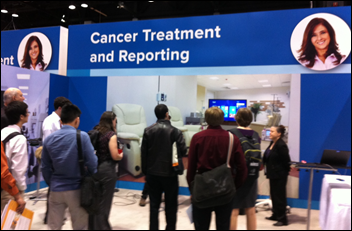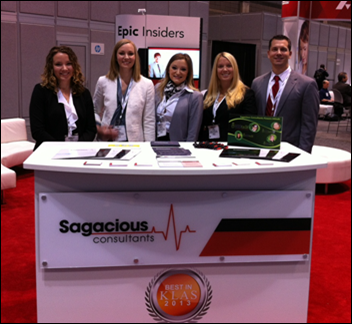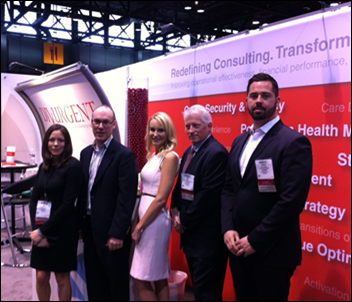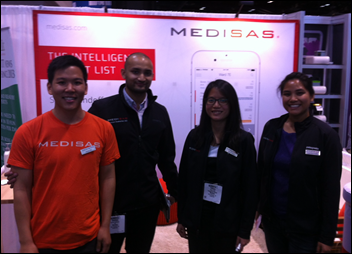"A valid concern..." Oh please. Everyone picks the software they like and the origin of that software is an afterthought.…
Jenn’s HIMSS Day 4 4/15/15
The end of my fifth HIMSS marked the first time I’ve ever had a flight cancelled. My unexpected stay in a Howard Johnson 20 minutes from O’Hare with just the clothes on my back and the electronics in my HIMSS book bag gave me extra time to mull over the rest of my HIMSS experience.
The fourth and final day of the conference for me was a bit more scheduled, with a few media briefings and a good chunk of time spent walking around the exhibit hall in one last attempt to get a flavor for what this year’s product offerings were all about. Buzzwords seen on booths and heard in show-floor conversations included value-based care, population health management, interoperability … the usual. Not much has changed in that area from an exhibit hall perspective, with the exception of EHRs no longer being the big-ticket item. They have turned into the backbone for everything else.
I chatted with the folks from Health Care DataWorks, which spent the bulk of its HIMSS promoting a variety of knowledge packs, pre-built dashboards build into its enterprise data warehouse that address 16 hospital areas including ER, OR, and patient-related analyses. HIStalk contributing author and Cedars-Sinai CIO Darren Dworkin made an appearance at a HCD roundtable early in the week to discuss how the health system used HCD business intelligence and analytics to achieve HIMSS Analytics Stage 7 status..

The folks at biometric identification company M2sys caught up with me to show me their first foray into mobile health. The RightPatient platform includes a mobile health app and wearable integration server that caters to both consumers and providers. The server takes data from consumer wearable devices and delivers it to the appropriate EHR, while the accompanying mobile app is the first I’ve seen that combines many most of us already have on our phones – personal health record, appointment scheduling, activity tracking, medication reminders, alerts, mood and health monitoring, and health games, to name a few. It can even be configured to accommodate the health data of multiple family members, with all data seamlessly transferred to their provider’s EHR.
I’ve been fairly vocal about the problem of having too many patient portals to log into, so it’s interesting to see the similar problem of having too many apps figured out via the aggregation of many into the distillation of one. President Michael Trader tells me that the platform will launch in July, with a mental health version already in the works.

My last show-floor one-on-one was with the Xerox and HealthSpot team. I have been interested in the HealthSpot remote-consultation kiosk for some time, and was happy to get a personal tour. My big question for CEO Steve Cashman was, “How is this a better option than picking up my phone while at home for care via a telemedicine app?” He confidently told me that going to a kiosk location offers benefits that a telemedicine app can’t match: reimbursement; a pipeline of HealthSpot physicians who also work for local hospitals and health systems; better quality of care; regulatory benefits (he kept bringing up the fact HealthSpot can operate in Texas); and automatic integration of health data via Xerox back-end technology into the patient’s EHR. The company is looking to launch its kiosks in 25 Rite-Aid stores in June. I’d definitely like to give it a try if they ever come to Georgia.

My inaugural visit to the Interoperability Showcase was an interesting one. The area was divided into a number of different “vignettes,” scenarios of patient care featuring family members going through different medical events. After a brief introduction by a healthcare IT magician in a central seating area, audience members dispersed to one of the vignettes, where we listened to three different docents run through the technologies involved in that particular family member’s diagnosis and treatment.

I decided to visit the oncology/clinical trials visit of 38 year-old patient Isabel, which involved technologies from Epic, InterSystems, and the CDC. As any hard-working member of the press would do, I whipped out my camera phone to document my experience, only to have the Epic rep immediately tell me that no pictures were allowed. He even followed me out of the presentation afterwards to ask that I delete any screenshots I may have taken. The one above is the only one I managed to get.
I walked over to a different vignette to see if they were as strict with their photography restrictions, only to find out they had no problem with photography. I snapped a few shots, but did notice that the rep working the video screen logged out of whatever application he was demoing as I snapped away. The whole experience left a bad taste in my mouth. Isn’t interoperability at its core about sharing data?
A few other random observations as I attempt to wrap up my coverage:
Interviews with Dana Moore: I heard from Lorre that it was his most worthwhile HIMSS experience, and it was certainly in demand. I love knowing that money raised from Mr. Moore’s time and expertise is going to a good cause like Donors Choose. It’s great to work for an employer that places importance on helping others. I saw several other companies highlighting their charitable efforts, including Dell and QuadraMed. HIMSS attendees also got the chance to spin Divurgent’s vibrantly colored Trivia Charity Wheel. Their spins helped the company raise $5,000 for Lurie’s Children’s Hospital of Chicago.


Customer service in the Windy City: It was fantastic, especially at McCormick Place. Everyone had smiles on their faces, and one security guard even chased after to me to ensure I went the right way to the West Hall.
Size and scope of the conference: I found the exhibit hall strangely confining despite its expansiveness. The press room was too far away from the exhibit hall to warrant my making the trek once or twice a day for a free meal, reliable WiFi, and quiet workspace to gather my thoughts and plan my show reviews. I’m not sure who thought putting zero restrooms in the exhibit hall would be a good idea – it certainly wasn’t for me. Like Mr. H and 35,000+ of our closest friends, I probably spent more time walking from point A to point B than in meetings, talking with vendors, or attending keynotes combined. For the record, I went through 10 Band-Aids on my poor blistered feet over my four days there.


Exhibitors: I managed to run into HIStalkapalooza sponsors Divurgent and Sagacious Consultants during my exhibit hall trek. Both teams kindly squeezed together for group shots. I can’t wrap up conference coverage without mention our gracious neighbors in the exhibit hall – Medisas and Oxford Healthcare IT. The Medisas team put up with a variety of shenanigans in and around the HIStalk booth, while the Oxford team kept us well fed with their daily buffet of Chicago-style hot dogs and Garrett’s popcorn.


Overall, I felt like I barely scratched the surface of what the show had to offer. I didn’t make it to any educational sessions other than Monday’s keynote, a similar experience to many of the providers I spoke to. It seems most people prefer to spend their time at HIMSS connecting with colleagues, and visiting vendors they otherwise wouldn’t be able to get to throughout the year. Perhaps next year I’ll take a different approach and spend most of my time in sessions rather than on the show floor. Given that it’s in Las Vegas, I can only hope the House of Blues there will be happy to host our next HIStalkapalooza. I hear Lorre is already entertaining sponsorship requests.
Contacts
Jennifer, Mr. H, Lorre, Dr. Jayne, Dr. Gregg, Lt. Dan
More news: HIStalk, HIStalk Connect.
Contact us online.
Become a sponsor.



Thank you for sharing your photo of our charity from the Dell Booth!!
Thank you for sharing your photo of our nonprofit, Brooke’s Blossoming Hope for Childhood Cancer Foundation from the Dell Booth! We hope you got to help make a blossom! http://www.BrookesBlossoms.org 🙂